|
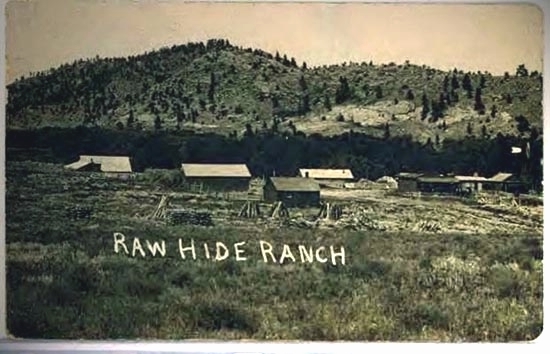
Rawhide Ranch, Rawhide Buttes, 1908
The Rawhide Ranch, the R Bar T or the "Damfino", was owned by Russell Thorp. There he had facilities to service the stage line. In addition to
barns, a store, stage station and other amenities were offered. Some of the barns are still in existence.
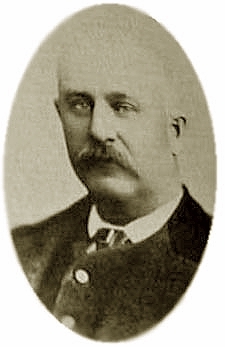
Russell Thorp, Sr.
Other ranches in the Lusk area included the
0-10 Bar owned by Col. Charles F. Coffee whose
home ranch was near Harrison, Nebraska. Coffee Siding, just across the
Nebraska line near Van Tassell, was established by Col. Coffee. Cattle would be trailed to
the siding from Niobrara and Goshen Counties in order to avoid higher freight rates
for cattle shipped from Wyoming. At its peak as many as five train loads of
cattle would be shipped daily from Coffee Siding. Today, Coffee Siding does not
appear on many maps of Nebraska, although Van Tassell, one of the smaller municipalities
in Wyoming, population either 8, 9, or 10 depending on who is doing the counting,
remains on most maps of Wyoming.
Other ranches owned by Coffee included the Square 3-Bar. Coffee, like many other ranchmen
received his start when he trailed cattle northward to Wyoming from Texas. And like many an early drover,
he was a Confederate veteran, having enlisted in the Confederate Army at age 13. His first trip was
in 1871. The trip was memorable for an angry confrontation outside of Cheyenne with an
individual claiming to be the mayor. The
young Coffee had watered his herd of 1800 longhorn in what proved to be the
city reservoir. Reminds one of the old cowboy wisdom, "Don't drink downstream from the herd."
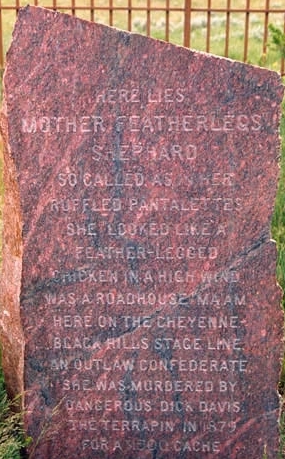
Featherlegs Shepard Monument, Silver Springs Road,
15 miles south of Lusk
The hog ranch at Ft. Laramie was not the only such establishment along the
stage road. To the north of Rawhide Buttes Station, the stage road, following
Rawhide Creek, swings to the west of the Buttes, passing in turn Little Rawhide
Butte, Middle Rawhide Butte, and Big Rawhide Butte. To the east of the road lie the abandoned Omaha and Copperbelt Mines.
Today, the hard road passes to the east of
the Buttes. In 1876, on Silver Springs Road, near Muskrat Canyon, about 1 1/2 miles south of the
Niobrara County line, Charlotte "Mother Featherlegs" Shephard established a
parlor where the lads could take their ease. The parlor was conveniently located at about the
point where the stage driver would "blow the horses" after the fifteen mile run south from
Silver Cliff. It was not much of a "parlor house," more
of a dugout. Mother Shephard was called "Featherlegs" because her pantalettes
gave her legs the appearance of chicken legs.
Allegedly, Mother Featherlegs had come west
from Louisiana following the death of her two sons, Tom and Bill, at the end of an extra-legal rope.
Northeast Louisiana below Vicksburg is an area of bayous, sloughs, swamps, and streams darkened by the natural tannin
in the water. During the Civil War outlaws and deserters from the War took refuge in the swamps, the chief of which
was the Tensas Swamp lying between the Mississippi and the Tensas River. Most of the men from the area
were away from hearth and home defending their
country from the Yankee invader. The occupants of the swamp thus used the opportunity to
help themselves to that which was not rightfully theirs. When the veterans returned home, they
found their farms pillaged and not necessarily by Yankees. The first task was to restore law and order. Among those
from the Tensas Swamp who fell victim to the restoration of order were Tom and Bill Shephard. Thus, Mother Featherlegs found
it expedient to move west.
In 1879, Mrs. O. J. Demmon, the wife of a Silver Springs rancher, lonely for
some conversation, drove the four miles from Silver Springs. There, beside a
spring, she found the murdered body of Mother Featherlegs. Shephard was apparently murdered by her
companion, a trapper named "Dangerous Dick" Davis, apparently for booty that
Shephard held for road agents that frequented the area. Among others who resided at Muskrat
Canyon for a short period was Calamity Jane. In 1964, in conjuntion with a reenactment of
a stage run, a 3,500 lb. granite monument was erected along the Cheyenne-Deadwood
Stage Road in Mother Shephard's memory. Among those contributing to the cost of the monument was
Del Burke, the proprietress of a similar establishment in Lusk.
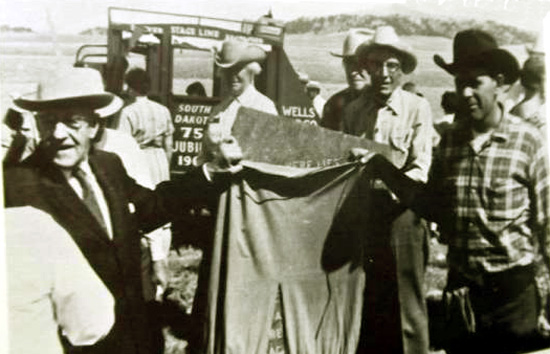
Dedication of Monument to Charlotte Shephard, Muskrat Canyon, Wyoming, 1964. Russell Thorp, Jr.
(1877-1968), in coat and tie, holding pantalettes.
Russell Thorp, Jr. grew up on the Rawhide Buttes ranch owned by his father. He is buried on a hillside overlooking the
ranch.
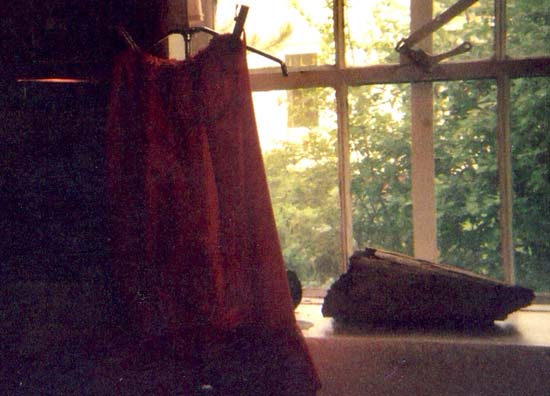
Mother Featherlegs' Pantalettes, Lusk Stagecoach Museum. Photo by
Geoff Dobson.
The Blackhills route lasted only 11 years. Railroads reached much of the
territory served by the line in 1886. Service was, thus, discontinued
with the
last coach, drawn by six horses and driven by George Lathrop accompanied by John Noonan, leaving
Cheyenne from in front of the Inter-Ocean Hotel on Feb. 19, 1887 (See photo at bottom of page).
By that time ownership of
the line had changed hands and it was owned by Russell Thorp.
The route had also changed, the Line's
literature advertising service to Chugwater,
Ft. Laramie, Lusk, Douglas, Buffalo and Deadwood. Three of the towns, Lusk, Douglas and Buffalo, had come into
existence during the eleven years.
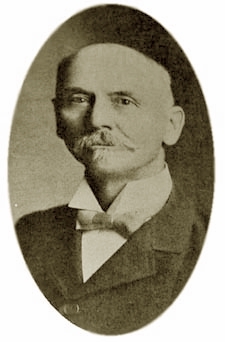
Luke Voorhees
Following discontinuance of the Deadwood Stage, Luke Voorhees (1835-1925), former manager of the line under Gilmer and Salsbury,
employed Lathrop on the Rawlins-Baggs stage line. When,
after four years, the postal contract expired, Voorhees then employed Lathrop to tend to his
copper mine at Muskrat Canyon near Rawhide Buttes. Voorhees had an involvement with a number of
stage lines throughout the west, including Colorado and Dakota Territory. The expiration of the
postal contract may have been as a result of the unhappiness of the Postmaster General with Voorhees' rates. Rates
were set based on the amount of equipment, men and animals needed to achieve requisite speed in the
delivery of the mails. The United States sued Voorhees claiming that he exaggerated the amount of
equipment needed to achieve the expedited speed of five miles an hour on a Dakota line
for which he was paid extra. The United States lost. A similar suit was filed against Voorhees over a
Colorado line Voorhees ran in the San Juan Mining District. Voorhees owned the L Z Ranch at Rawhide and also had cattle interests in Montana and served
as Wyoming treasurer for two years.
With Lathrop's advancing age, Thomson H. "Tom" Black, owner of the 4-Bar at Willow, adopted
Lathrop as a member of his family and urged him to write his memoirs. Black (1861-1932) had worked as the station agent at the
Rawhide station. In 1915, perhaps feeling that
the end was near, Lathrop finally wrote of his experiences.
On Christmas Eve, 1915, Lathrop's
85th birthday, he arose from his bed and called to Daniel W. Smith in the next room. Smith
responded to the call and found Lathrop dead. Following Lathrup's death, the handwritten memoirs were given to
the Lusk
Herald, which printed and distributed them to subsribers. A later reprint
was sold for fifty cents a copy, with the proceeds used by the Herald to pay for a grave marker. Today, a state rest area, along the
old Deadwood Stage Road is dedicated to Lathrop's memory. The last words of the
autobiography: "So long, Boys."
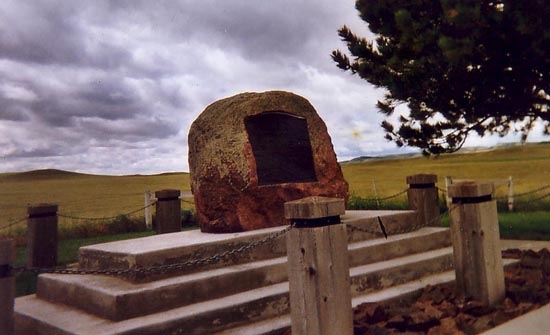
Lathrop Monument, west of Lusk. Photo by Geoff Dobson
the monument was dedicated in 1930 with former Governor B. B. Brooks presiding over the ceremony. Harry Hines who had worked as
blacksmith for the stage line attended as did Dr. Hebbard. In the distance on the right hand side of the photo
may be seen the line of the stage road. The inscription on the monument:
IN MEMORY OF
GEORGE LATHROP
PIONEER OF THE WEST, INDIAN FIGHTER, VERTERAN STAGE DRIVER
BORN AT POTTSVILLE, PA., DECEMBER 24, 1820
DIED AT WILLOW, WYO., DEC. 24, 1915
BURIED HERE
"A GOOD MAN WHOSE LIFE WAS FILLED WITH STIRRING EVENTS"
MARKING THE CHEYENNE AND BLACK HILL TRAIL.
THIS MARKER IS ERECTED ON THE OLD CHEYENNE AND BLACK HILLS STATE ROAD
IN MEMORY OF THE OPERATORS OF THE LINE AND THE PIONEERS WHO TRAVELED IT.
OPERATORS OF THE STAGE LINE: LUKE VOORHEES, RUSSELL THORP, SR.
|
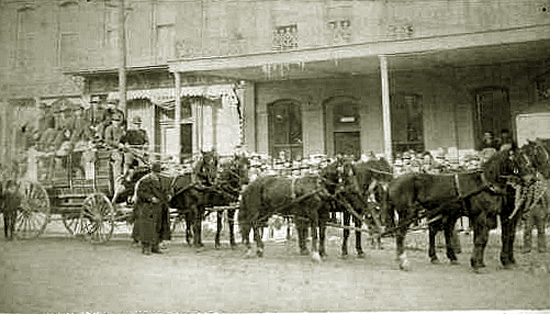
Last Cheyenne and
Blackhills Stage leaving from in front of Inter-Ocean Hotel, Feb. 19, 1887, George
Lathrop driver, Russell Thorp, Sr. standing next to wheel horse. Photo by
C. D. Kirkland.
Next page: Lusk.
|